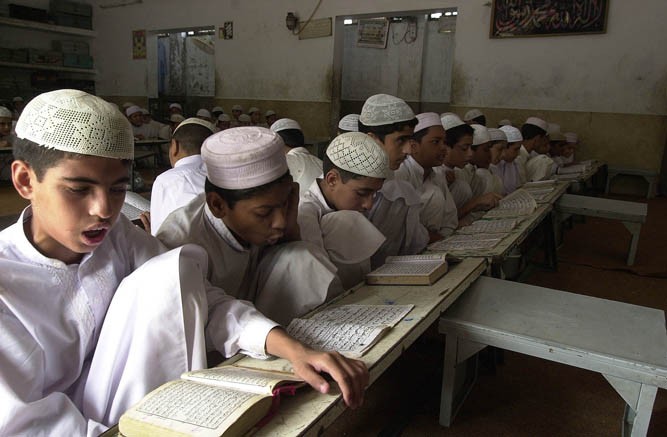
Tracing the role of madrassas in spreading radicalisation

Madrassas are held responsible for spreading radicalistion in society and promoting extremism. Punjab, being the biggest province, is seen as having its share of radicalisation spread by these madrassas.
Currently, madrassas in Punjab are under the scrutiny of the provincial government. In the National Action Plan, points 10 and 18 mention the state’s resolve to register and regulate madrassas and eradicate sectarian terrorism.
Questions like how many madrassas are located in Punjab, who funds them, and what is being done to regulate them have repeatedly been raised in the media.
There are conflicting figures about the number of madrassas in Punjab, between 14,000 and 16,000, says Umair Khalil, lead researcher of the non-governmental research organisation, HIVE, in a report titled, "The Madrassa Conundrum -- The state of religious education in Pakistan."
According to news reports, the Punjab government completed geo-tagging of 11,000 religious seminaries across Punjab and compiled their sect-wise breakdown in March last year. The geo-tagging data includes details about the seminaries. The geo-tagging was done under the National Action Plan (NAP).
A report published by Pildat in 2015, "Madrassa Education 2014: Challenges, Reforms and Possibilities" states that the biggest challenge to the government is about the number of these madrassas in the country, or in Punjab for that matter. "Some 19,104 madrassas were registered with the government back in March 2010 but the common estimated range is around 20,000-30,000."
It further says, "According to a report of the UK Department for International Development DFID, more statistical and systematic information is needed to address gaps in knowledge and curriculum and more accurate estimates are required for the number of madrassas, enrolled students, graduates and change in employability prospects after modernisation."
The report proposes that "An auditing team should be made (by the government) for madrassa expenditure to account for their activities and spending. Funding should come from the general education budget, as programme-specific funds from Western donors may generate distrust."
In "Radicalisation: A Dilemma of Pakistan (August 2015)," Asad Ullah Khan, Research Fellow, Institute of Strategic Studies (ISSI), points out that, "The most vulnerable target of radicalisation in the country has been the youth. In villages, most people cannot afford the schooling of their children, so they send them to the madrassas either in boarding or as day scholars."
He further explains that "The teaching method in madrassa and their curriculum is not fully state-controlled. Around 20,560 madrassas are registered with Wafaq-ul-Madaris, but they are not governed or controlled by the government." The paper suggests, "There should be standard operating procedures (SOP) for running madrassas like NGOs in the country."
In "Trends and Patterns of Radicalization in Pakistan" published by Pak Institute of Peace Studies (PIPS) in April 2010, Mujtaba Rathore and Abdul Basit look at the causes of radicalisation in the country, "The main causes of radicalisation across the country are political marginalisation, poverty,… illiteracy, the role of madrassas and the indoctrination agendas of militant organisations, which exploit these factors."
"These madrassa networks, which are scattered across the country, have inherent differences along sectarian lines and political attitudes and promotion of the ‘jihad’ agenda have contributed to the existing wave of radicalisation in Pakistan," he says. The four major Muslim sects -- Barelvi, Deobandi, Shia and Ahl-e-Hadees -- have their separate mosques and networks of madrassas.
According to news reports, last year in November the interior ministry told lawmakers that it had sealed 102 madrassas for fanning extremism. Of which only two seminaries were closed down in Punjab where a number of students were found in contact with banned groups while 87 madrassas were closed down in Sindh and 13 in Khyber-Pakhtunkhwa.
News reports say that in February last year, the Punjab government admitted that some 17 Muslim and non-Muslim countries were contributing hundreds of millions of rupees to around 1,000 religious seminaries in the province. This was disclosed by the special branch of Punjab police in a document submitted to Chairman Senate Standing Committee on Rules of Procedure and Privileges, Senator Col (retd) Tahir Mashhadi.
The special branch enlisted over 950 seminaries in Punjab. It is believed that the seminaries were receiving hundreds of millions of rupees from various countries. The Interior Ministry in its written reply to the committee had informed the lawmakers about the countries and the funds they contributed to madrassas in Pakistan, which included Qatar, Kuwait, Saudi Arabia, Dubai, and Bahrain among others.
Tracing the role of madrassas in spreading radicalisation, Azmat Abbas, senior journalist and researchers who specialises on the issue of extremism and madrassa reforms, says, "Madrassas have played a big role in spreading radicalisation in Punjab or in other provinces of the country for that matter. But madrassas have not done that as an institution but through an environment that they create and the way they teach their students."
He further says that "It is difficult to single out a madrassa or madrassas in Punjab because no one has so far been apprehended or sentenced from a madrassa for spreading radicalisation or committing terrorism."
He explains it by saying, "More recruits for the Afghan jihad came from the mainstream institutions of Jamaat-e-Islami and other schools and colleges than from madrassas in Punjab or elsewhere. In South Punjab, for example, it is not just radicalisation promoted by madrassas but also a combination of poverty, illiteracy and underdevelopment."
Punjab has been seen by experts as being a sanctuary for terrorists and many madrassas being their hotbeds. It is widely believed that government representatives once saw their electoral strength in the extremist elements, particularly in Punjab which had given support to madrassas in the 1980s.
After partition, many madrassas, like Khair ul Madaris, Jamia-i-Rashidia or Tajweed ul Quran, were relocated to the Punjab. The number of madrassas grew manifold during and after the reign of Ziaul Haq. After 9/11, Gen. Musharraf tried to regulate madrassas by introducing madrassa reforms, which is still an on-going process.